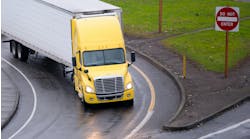It hasn’t been easy for truck drivers to start using electronic logging devices (ELDs) after they were mandated into use last year, especially the many veterans with decades of experience used to paper logs. But as time goes by, they should see fatter paychecks and improved workday schedules. We wrap up our weeklong series on how ELDs are changing trucking with a look how drivers can benefit from the mandatory gadget.
Check out the other three parts of the series:
- Respecting your ELDers: The extra benefits
- Are ELDs making trucking safer?
- How ELDs are making and saving fleets more money
Equality and better deals for drivers
“ELDs have helped to level the playing field by having a standard set of rules that all carriers must follow,” said John Wilbur, CEO of Roadmaster Group, a specialized transportation company.
“The implementation of ELDs is changing the industry’s mindset on non-driving hours. They have brought about an awareness to the abuse of a driver’s time, which can no longer be covered up through interpretive logbook editing. With the clock always running, carriers must be compensated for excessive wait times,” Wilbur continued. “The data provided through ELDs provides the carrier with quality wait-time information that can be presented back to shippers. ELDs establish proof of a driver’s downtime, whether they are taking a break or being detained at a shipper/receiver.”
Will Salter, CEO of Paragon Software Systems, which provides routing and scheduling software used by global transportation operations, remarked that ELDs, by their nature, provide reliably accurate data on truck-driving activities, including hours driven, idling time, and being stuck in slow traffic. When that data is put to good use, it reduces inefficiencies in the system and extra costs.
“This removes the need to manually manipulate the data to ensure HOS restrictions are adhered to,” he said. “If a driver is habitually using less than the maximum HOS on a particular route, the routing plan will automatically add a delivery leg, or move the driver to another route that maximizes use of the allowance. With more accurate route plans, you can push drivers’ hours on the road to the absolute maximum, confident they won’t get stranded with a load at the end of their 10- or 11-hour shift.”
Forcing shippers to improve their operations
“ELDs, onboard recorders, and other telematics systems have certainly provided more data to carriers,” explained Taylor Howerton, head of SunTrust Bank’s logistics & supply chain industry vertical. “In turn, carriers are using this data to help negotiate with shippers and incentivize them to improve performance and readiness at their docks. Better information also fosters increased carrier-shipper collaboration, which has been a theme as capacity tightens.
“In any environment,” he said, “there’s an incentive to create more density in your lanes, reduce empty miles, and select accounts that provide the best efficiency and margin to your operation. Increased information coming out of tech-enabled fleets is helping carriers build smarter networks and can really accelerate their profitability if they are disciplined in their approach to the marketplace.”
Ozzie Flores, marketing and product manager for Teletrac Navman, which provides cloud-based GPS fleet-tracking software reported that his company’s research found approximately 28% of carriers report drivers losing available HOS time due to delays in loading and unloading at shipper or receiver locations.
“I also have personal experience with peers and friends who have been negatively affected by situations with inefficient time usage,” he said. “In many cases, drivers who were paid by the load were able to prove through GPS tracking, location data, and ELD detention time that they were unable to make the required delivery amounts due to these types of extenuating circumstances and were able to recover lost wages as a result.”
Eric Witty, vice president of product at Trimble Transportation, which provides integrated onboard computing and mobile communications systems enabling fleets to get data-driven business intelligence, summed up the effect ELDs will continue to have on trucking. “Telematics systems have been providing insight into travel times, traffic, detention times, etc., for years to early adopters,” he said. “The ELD mandate will now just provide the opportunity for these benefits to be realized more broadly.”
* * *



